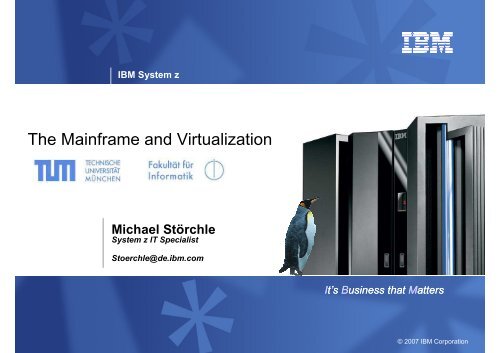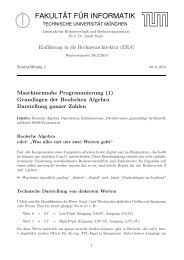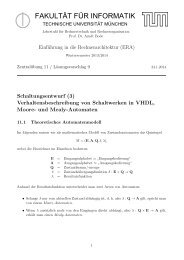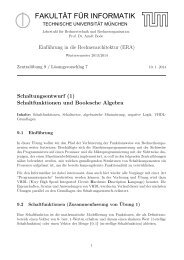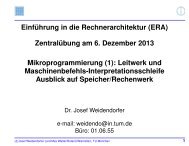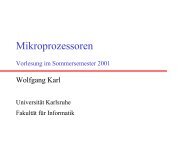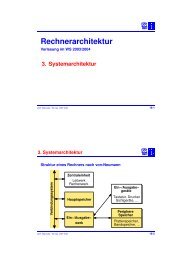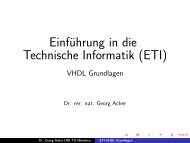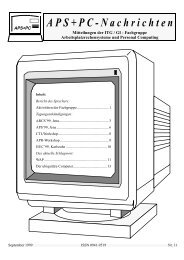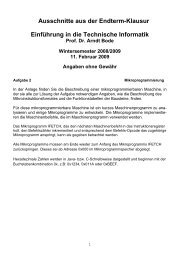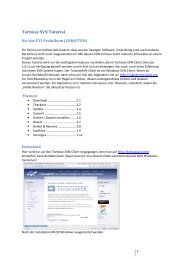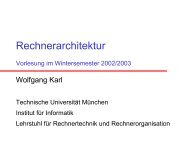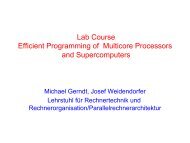The Mainframe and Virtualization - LRR
The Mainframe and Virtualization - LRR
The Mainframe and Virtualization - LRR
Create successful ePaper yourself
Turn your PDF publications into a flip-book with our unique Google optimized e-Paper software.
IBM System z<br />
<strong>The</strong> <strong>Mainframe</strong> <strong>and</strong> <strong>Virtualization</strong><br />
Michael Störchle<br />
System z IT Specialist<br />
Stoerchle@de.ibm.com<br />
v<br />
It’s Business that Matters<br />
© 2007 IBM Corporation
IBM System z<br />
Trademarks<br />
It‘s Business that Matters<br />
<strong>The</strong> following are trademarks of the International Business Machines Corporation in the United States <strong>and</strong>/or other countries. For a complete list of IBM Trademarks, see www.ibm.com/legal/copytrade.shtml: AS/400,<br />
DB2, e-business logo, ESCON, eServer, FICON, IBM, IBM Logo, iSeries, MVS, OS/390, pSeries, RS/6000, S/390, System z9, VM/ESA, VSE/ESA, WebSphere, xSeries, z/OS, zSeries, z/VM.<br />
<strong>The</strong> following are trademarks or registered trademarks of other companies<br />
Java <strong>and</strong> all Java-related trademarks <strong>and</strong> logos are trademarks of Sun Microsystems, Inc., in the United States <strong>and</strong> other countries.<br />
LINUX is a registered trademark of Linux Torvalds in the United States <strong>and</strong> other countries.<br />
UNIX is a registered trademark of <strong>The</strong> Open Group in the United States <strong>and</strong> other countries.<br />
Microsoft, Windows <strong>and</strong> Windows NT are registered trademarks of Microsoft Corporation.<br />
SET <strong>and</strong> Secure Electronic Transaction are trademarks owned by SET Secure Electronic Transaction LLC.<br />
Intel is a registered trademark of Intel Corporation.<br />
* All other products may be trademarks or registered trademarks of their respective companies.<br />
NOTES:<br />
Performance is in Internal Throughput Rate (ITR) ratio based on measurements <strong>and</strong> projections using st<strong>and</strong>ard IBM benchmarks in a controlled environment. <strong>The</strong> actual throughput that any user will experience will vary<br />
depending upon considerations such as the amount of multiprogramming in the user's job stream, the I/O configuration, the storage configuration, <strong>and</strong> the workload processed. <strong>The</strong>refore, no assurance can be given that<br />
an individual user will achieve throughput improvements equivalent to the performance ratios stated here.<br />
IBM hardware products are manufactured from new parts, or new <strong>and</strong> serviceable used parts. Regardless, our warranty terms apply.<br />
All customer examples cited or described in this presentation are presented as illustrations of the manner in which some customers have used IBM products <strong>and</strong> the results they may have achieved. Actual environmental<br />
costs <strong>and</strong> performance characteristics will vary depending on individual customer configurations <strong>and</strong> conditions.<br />
This publication was produced in the United States. IBM may not offer the products, services or features discussed in this document in other countries, <strong>and</strong> the information may be subject to change without notice.<br />
Consult your local IBM business contact for information on the product or services available in your area.<br />
All statements regarding IBM's future direction <strong>and</strong> intent are subject to change or withdrawal without notice, <strong>and</strong> represent goals <strong>and</strong> objectives only.<br />
Information about non-IBM products is obtained from the manufacturers of those products or their published announcements. IBM has not tested those products <strong>and</strong> cannot confirm the performance, compatibility, or any<br />
other claims related to non-IBM products. Questions on the capabilities of non-IBM products should be addressed to the suppliers of those products.<br />
Prices subject to change without notice. Contact your IBM representative or Business Partner for the most current pricing in your geography.<br />
References in this document to IBM products or services do not imply that IBM intends to make them available in every country.<br />
Any proposed use of claims in this presentation outside of the United States must be reviewed by local IBM country counsel prior to such use.<br />
<strong>The</strong> information could include technical inaccuracies or typographical errors. Changes are periodically made to the information herein; these changes will be incorporated in new editions of the publication. IBM may<br />
make improvements <strong>and</strong>/or changes in the product(s) <strong>and</strong>/or the program(s) described in this publication at any time without notice.<br />
Any references in this information to non-IBM Web sites are provided for convenience only <strong>and</strong> do not in any manner serve as an endorsement of those Web sites. <strong>The</strong> materials at those Web sites are not part of the<br />
materials for this IBM product <strong>and</strong> use of those Web sites is at your own risk.<br />
2 IBM System z<br />
© 2007 IBM Corporation
IBM System z<br />
Agenda<br />
It‘s Business that Matters<br />
1 Server <strong>Virtualization</strong> Basics <strong>and</strong> Business Value<br />
2 IBM System z <strong>Virtualization</strong> Differentiation<br />
3 IBM System z<br />
© 2007 IBM Corporation
IBM System z<br />
It‘s Business that Matters<br />
<strong>Virtualization</strong> – Say What?<br />
Virtual Resources<br />
� Proxies for real resources: same interfaces/functions, different attributes.<br />
� May be part of a physical resource or multiple physical resources.<br />
<strong>Virtualization</strong><br />
� Creates virtual resources <strong>and</strong> "maps" them to real resources.<br />
� Primarily accomplished with software <strong>and</strong>/or firmware.<br />
Resources<br />
� Components with architected interfaces/functions.<br />
� May be centralized or distributed. Usually physical.<br />
� Examples: CPUs, memory, storage, network devices.<br />
� Separates presentation of resources to users from actual resources<br />
� Aggregates pools of resources for allocation to users as virtual resources<br />
4<br />
IBM System z<br />
© 2007 IBM Corporation
IBM System z<br />
It‘s Business that Matters<br />
<strong>Virtualization</strong> – Say What?<br />
� <strong>Virtualization</strong> comprises the abstraction of physical systems to<br />
virtual systems<br />
– Divison of static relationships between logical system environments<br />
(environment of services <strong>and</strong> applications) <strong>and</strong> physical systems<br />
– Two possible directions:<br />
Integration of many single physical systems to one logical system<br />
Segmentation of one physical system into many logical systems<br />
– Such „logical systems“ are named as virtual machines<br />
– A virtual machine is a fully protected <strong>and</strong> isolated simulation of the<br />
underlaying hardware<br />
...altough virtualization comprises both integration <strong>and</strong><br />
segmentation, this presentation concentrates on segmentation.<br />
5 IBM System z<br />
© 2007 IBM Corporation
IBM System z<br />
It‘s Business that Matters<br />
Important Terms Concerning <strong>Virtualization</strong><br />
� Supervisor <strong>and</strong> Hypervisor<br />
– Supervisor is another term for an operating system of an virtual machine<br />
Controls the virtual machine <strong>and</strong> its dedicated resources<br />
– Hypervisor (or Virtual Machine Monitor) is another term for an controller of<br />
virtual machines<br />
Controls the physical system resources <strong>and</strong> dedicates them to virtual machines.<br />
Controls <strong>and</strong> h<strong>and</strong>les processes of virtual machines which are critical to physical hardware<br />
Isolation of virtual machines<br />
Switching (context switching) between virtual machines (e.g., exits, time slicing...)<br />
Supervisor Supervisor Supervisor Supervisor<br />
Hypervisor<br />
Physical Resources<br />
6 IBM System z<br />
© 2007 IBM Corporation
IBM System z<br />
It‘s Business that Matters<br />
Important Terms Concerning <strong>Virtualization</strong><br />
� Kernel (Privileged) Mode <strong>and</strong> User Mode<br />
– Kernel Mode provides full access to system resources. It is the mode of the<br />
operating system which administers <strong>and</strong> dedicates physical system resources.<br />
– User Mode provides restricted access to system resources (e.g., applications)<br />
� Privileged <strong>and</strong> Non-Privileged instructions<br />
– Privileged instructions can only be executed within Kernel Mode<br />
� Sensitive <strong>and</strong> Non-Sensitive instructions<br />
– Sensitive instructions invoke critical hardware areas<br />
Application<br />
Operating<br />
System<br />
Non-Privileged<br />
Privileged<br />
Application<br />
Operating<br />
System<br />
Hypervisor<br />
Non-Privilege<br />
Non-Privileged<br />
Privileged<br />
7 IBM System z<br />
© 2007 IBM Corporation
IBM System z<br />
It‘s Business that Matters<br />
Important Terms Concerning <strong>Virtualization</strong><br />
� What is a Virtualizable Architecture?<br />
– Sensitive Instructions are also Privileged<br />
– E.g., System z<br />
� What is a Non-Virtualizable Architectur?<br />
– Sensitive Instructions are NOT always also Privileged<br />
– E.g., x86<br />
8 IBM System z<br />
© 2007 IBM Corporation
IBM System z<br />
It‘s Business that Matters<br />
Server <strong>Virtualization</strong> Approaches<br />
Hardware Partitioning Bare Metal Hypervisor Hosted Hypervisor<br />
Partition<br />
Controller<br />
Apps<br />
OS<br />
...<br />
Adjustable<br />
partitions<br />
SMP Server<br />
Apps<br />
OS<br />
Server is subdivided into fractions<br />
each of which can run an OS<br />
Physical partitioning<br />
S/370 SI-to-PP <strong>and</strong> PP-to-SI,<br />
Sun Domains, HP nPars<br />
Logical partitioning<br />
pSeries LPAR, HP (PA) vPars<br />
Apps<br />
OS<br />
...<br />
Hypervisor<br />
SMP Server<br />
Hypervisor software/firmware<br />
runs directly on server<br />
System z PR/SM <strong>and</strong> z/VM<br />
POWER Hypervisor<br />
VMware ESX Server<br />
Xen Hypervisor<br />
Hypervisor software runs on<br />
a host operating system<br />
VMware GSX<br />
Microsoft Virtual Server<br />
HP Integrity VM<br />
User Mode Linux<br />
9 IBM System z<br />
© 2007 IBM Corporation<br />
Apps<br />
OS<br />
Type 1<br />
Hypervisor provides fine-grained<br />
timesharing of all resources<br />
• Hardware partitioning subdivides a server into fractions, each of which can run an OS<br />
• Hypervisors use a thin layer of code to achieve fine-grained, dynamic resource sharing<br />
• Type 1 hypervisors with high efficiency <strong>and</strong> availability will become dominant for servers<br />
• Type 2 hypervisors will be mainly for clients where host OS integration is desirable<br />
Apps<br />
OS<br />
...<br />
Hypervisor<br />
Host OS<br />
SMP Server<br />
Apps<br />
OS<br />
Type 2<br />
Hypervisor uses OS services to<br />
do timesharing of all resources
IBM System z<br />
Virt Mach<br />
L<br />
A<br />
ST<br />
PrivOp<br />
L<br />
...<br />
It‘s Business that Matters<br />
Trap <strong>and</strong> Emulate<br />
Examples: CP-67, VM/370<br />
Benefits: Runs unmodified OS<br />
Issues: Substantial overhead<br />
Hypervisor Calls (“Paravirtualization”)<br />
Virt Mach<br />
L<br />
A<br />
ST<br />
Hcall<br />
L<br />
...<br />
Trap<br />
Call<br />
• VM runs in user mode<br />
• All privileged instructions<br />
cause traps<br />
Hypervisor PrivOp<br />
emulation code<br />
• VM runs in normal modes<br />
• OS in VM calls hypervisor<br />
in case of critical Syscalls<br />
Hypervisor<br />
service<br />
Examples: POWER Hypervisor, Xen (today),<br />
HP Integrity VM<br />
Benefits: High efficiency depending of<br />
Hypervisor code + eventual HW support<br />
Issues: OS-Kernel must be modified to issue Hcalls.<br />
OS & Hypervisor levels must be in sync<br />
Hypervisor Implementation Methods<br />
Translate, Trap, <strong>and</strong> Emulate<br />
Virt Mach<br />
L<br />
A<br />
ST<br />
TrapOp<br />
L<br />
...<br />
Direct Hardware <strong>Virtualization</strong><br />
Virt Mach<br />
L<br />
A<br />
ST<br />
PrivOp(*)<br />
L<br />
...<br />
• VM runs in normal modes<br />
• HW does most of the virtualization<br />
• SIE arch – set architecture of VM,<br />
provide status, translation & assists)<br />
• Hypervisor provides control<br />
Hypervisor<br />
service<br />
10<br />
IBM System z<br />
© 2007 IBM Corporation<br />
Trap<br />
Exit<br />
• VM runs in user mode<br />
• Some IA-32 instructions must<br />
be replaced with trap ops<br />
Hypervisor PrivOp<br />
emulation code<br />
Examples: VMware (today), Microsoft VS<br />
Benefits: Runs unmodified, translated OS<br />
Issues: May have some substantial overhead<br />
(*) ONLY for some<br />
control instructions,<br />
executed rather<br />
infrequent<br />
Examples: PR/SM, z/VM (also use hypervisor<br />
calls for a some functional enhancements)<br />
Benefits: Highest efficiency depending on<br />
HW/ucode support. Runs unmodified OS<br />
Issues: Requires HW & ucode support
IBM System z<br />
It‘s Business that Matters<br />
Partitioning Defined<br />
� Partitioning is the division of a single server’s resources* into multiple, independent,<br />
isolated systems capable of running their own operating system<br />
� Three types of partitioning:<br />
– Hardware – resources are allocated to partitions on a one-to-one basis with the<br />
underlying physical hardware (no sharing among partitions)<br />
– Logical – resources are managed by hardware firmware <strong>and</strong> allocated to<br />
partitions with a finer granularity than hardware partitioning (resource sharing<br />
among partitions)<br />
– Software – resources are managed by a software layer, aggregated into shared<br />
resource pools, <strong>and</strong> apportioned to users as virtual system resources, separating<br />
the presentation of the resources from the actual physical entities<br />
* Resources include: processors, memory, I/O adapters <strong>and</strong> devices, networking interfaces, co-processors<br />
11 IBM System z<br />
© 2007 IBM Corporation
IBM System z<br />
It‘s Business that Matters<br />
Hypervisor Technologies<br />
“Trap <strong>and</strong> Emulate” method<br />
� Guest OS runs in user mode<br />
� Hypervisor runs in privileged mode<br />
� Privileged instructions issued by guest operating system(s) are trapped by<br />
hypervisor<br />
� IA-32 (Intel) complications:<br />
Some instructions behave differently in privileged <strong>and</strong> user modes<br />
User mode instructions that access privileged resources/state cannot be trapped;<br />
instruction must be changed to something that can be trapped<br />
� Some guest kernel binary translation may be required - “Translate, Trap <strong>and</strong><br />
Emulate” method<br />
Reduces resource-overhead<br />
� Originally used by mainframes in 1960s <strong>and</strong> 1970s (VM/370)<br />
� Used today by VMware<br />
12 IBM System z<br />
© 2007 IBM Corporation
IBM System z<br />
It‘s Business that Matters<br />
Hypervisor Technologies<br />
Hypervisor Call method (“Paravirtualization”)<br />
� Guest OS runs in privileged mode<br />
� Hypervisor runs in super-privileged mode<br />
� Guest OS kernel (e.g., AIX, i5/OS, Linux) is modified to do hypervisor calls for I/O,<br />
memory management, yield rest of time slice, etc.<br />
� Memory mapping architecture is used to isolate guests from each other <strong>and</strong> to<br />
protect the hypervisor<br />
� Used by POWER5 today<br />
13 IBM System z<br />
© 2007 IBM Corporation
IBM System z<br />
It‘s Business that Matters<br />
Hypervisor Technologies<br />
Direct Hardware method<br />
� Guest OS runs in privileged mode<br />
� Guest OS can be run unmodified, but can issue some hypervisor calls to improve<br />
performance or capability<br />
I/O (z/VM)<br />
Yield time slice (PR/SM TM <strong>and</strong> z/VM)<br />
� Extensive hardware assists for hypervisor (virtual processor dispatching, I/O<br />
pass-through, memory partitioning, etc.)<br />
� Used by System z (PR/SM TM <strong>and</strong> z/VM)<br />
14 IBM System z<br />
© 2007 IBM Corporation
IBM System z<br />
It‘s Business that Matters<br />
Let’s talk about…<br />
Business Value!<br />
15 IBM System z<br />
© 2007 IBM Corporation
IBM System z<br />
It‘s Business that Matters<br />
What are data centres facing today?<br />
Exploiding numbers of systems!<br />
16 IBM System z<br />
© 2007 IBM Corporation
IBM System z<br />
It‘s Business that Matters<br />
Data Center Heating<br />
Source: Uptime Institute,<br />
Footprint – Heat Density Trends<br />
17 IBM System z<br />
© 2007 IBM Corporation
IBM System z<br />
It‘s Business that Matters<br />
Why perform the effort of virtualization? - <strong>The</strong> Business Value!<br />
� Reduced hardware costs<br />
– Higher physical resource utilization<br />
– Smaller footprints<br />
� Reduced management costs<br />
– Fewer physical servers to manage<br />
– Many common management tasks become much easier<br />
� Improved flexibility <strong>and</strong> responsiveness<br />
– Virtual resources can be adjusted dynamically to meet new or changing needs<br />
<strong>and</strong> to optimize service level achievement<br />
– Provisioning <strong>and</strong> removing of servers within minutes<br />
Roles:<br />
Consolidations<br />
Dynamic provisioning / hosting<br />
Workload management<br />
Workload isolation<br />
Software release migration<br />
Mixed production <strong>and</strong> test<br />
Mixed OS types/releases<br />
Reconfigurable clusters<br />
Low-cost backup servers<br />
Virtual Servers<br />
<strong>Virtualization</strong><br />
<strong>Virtualization</strong> based on SHARING RESSOURCES<br />
allows an installation to grow<br />
dynamically both Vertically & Horizontally<br />
on the same server<br />
assuming we are dealing with<br />
Efficient <strong>Virtualization</strong><br />
Physical<br />
Server<br />
Benefits:<br />
Higher resource utilization<br />
Greater usage flexibility<br />
Improved workload QoS<br />
Higher availability / security<br />
Lower cost of availability<br />
Lower management costs<br />
Improved interoperability<br />
Legacy compatibility<br />
Investment protection<br />
18 IBM System z<br />
© 2007 IBM Corporation
IBM System z<br />
Agenda<br />
It‘s Business that Matters<br />
1 Server <strong>Virtualization</strong> Basics <strong>and</strong> Business Value<br />
2 IBM System z <strong>Virtualization</strong> Differentiation<br />
19 IBM System z<br />
© 2007 IBM Corporation
IBM System z<br />
It‘s Business that Matters<br />
IBM <strong>Virtualization</strong> Evolution<br />
40 Jahre kontinuierliche Innovation<br />
Der IBM <strong>Mainframe</strong> ist Pionier und Perfektionist auf dem Gebiet der Virtualisierung<br />
System i & p haben fortschrittliche Hypervisor mit PR/SM-ähnlicher Funktionalität<br />
Andere Server hinken mit ihren Virtualisierungsmechanismen nach<br />
S/360 <br />
CP-67<br />
Programmable<br />
Operator<br />
Hypervisor Control<br />
Program<br />
Z900 / z890<br />
1967 1970 1980 1990 2000<br />
<strong>Mainframe</strong><br />
Z990 / z890<br />
Z9 EC/BC<br />
zAAPs<br />
ZIIPs<br />
20 IBM System z<br />
© 2007 IBM Corporation<br />
zVM<br />
zAAPs<br />
ZIIPs<br />
VM/370<br />
VM/ESA<br />
VM/XA<br />
VM/HPO<br />
VM/SP<br />
®<br />
EXEC<br />
9672 G2 - G6<br />
z/VM<br />
9x21<br />
3090<br />
64-bit<br />
308x<br />
303x<br />
PR/SM<br />
QDIO Adapter<br />
ESA<br />
4381<br />
Interrupt Assist<br />
158/168<br />
EMIF FCP / SCSI<br />
64 MB real 31-bit<br />
Guest Lan<br />
Dynamic Stg<br />
SIE<br />
Reconfig II HiperSockets<br />
instruction<br />
(DSR II)<br />
N-way<br />
CMS pipelines<br />
Virtual Switch<br />
XEDIT<br />
Logical<br />
Virtual<br />
VM assist<br />
Partitioning<br />
Disk<br />
Integrated Facility<br />
microcode<br />
REXX TRACE<br />
For Linux (IFL)<br />
Multiple<br />
Subchannel<br />
Sets<br />
other<br />
assists<br />
Multiple<br />
Channel<br />
Sub-<br />
Systems<br />
PER<br />
IUCV TRAP<br />
IRD<br />
Advanced<br />
Paging<br />
Subsystem<br />
Resource<br />
Capping<br />
Performance<br />
Toolkit<br />
pAVE<br />
Micropartitioning<br />
Shared<br />
File<br />
System<br />
i & pSeries<br />
AS/400<br />
LPAR VIOS<br />
LPAR DLPAR<br />
Inte VT<br />
XEN AMD SVT<br />
VMware<br />
N-Port<br />
<strong>Virtualization</strong><br />
(NPVI)<br />
Unix<br />
x86<br />
LPAR<br />
Group<br />
Capacity<br />
2007
IBM System z<br />
Memory<br />
It‘s Business that Matters<br />
System z <strong>Virtualization</strong> Architecture<br />
HiperSockets & Virtual Networking <strong>and</strong> Switching<br />
VM<br />
VM<br />
Test<br />
Web<br />
Sphere<br />
VM<br />
SysAdmin<br />
Tools<br />
Apache<br />
Linux Linux CMS Linux<br />
SIE & SIE Assists<br />
z/VM z/OS z/OS z/VM<br />
IFL Processors<br />
LPAR 1<br />
VM<br />
I/O & Network<br />
WebSphere<br />
Memory<br />
LPAR 2<br />
Processors<br />
Traditional<br />
OLTP <strong>and</strong><br />
Batch<br />
WLM WLM<br />
Memory<br />
LPAR 3<br />
HW/ucode functions - SIE & SIE assist<br />
Processor Resource / System Manager (PR/SM)<br />
VM VM<br />
FTP<br />
Linux<br />
Test<br />
Memory<br />
z/OS<br />
SIE & SIE Assists<br />
LPAR 4<br />
Intelligent Resource Director (IRD)<br />
Multi-Dimensionale Virtualisierung<br />
� HW: PR/SM (LPAR’s) & SW: zVM (VM’s)<br />
� Isolierte Umgebungen: EAL5 für PR/SM und<br />
EAL3+ für z/VM<br />
� Hochentwickelter Hypervisor<br />
� SIE Instruktion: Virtualsierung ist eingebaut, kein<br />
Add-On<br />
� 10% der Integrierten Schaltkreise werden für<br />
Virtualisierung benutzt (SIE)<br />
� Zeit- und Ereignisgesteuertes Dispatching<br />
� SHARED ALL Architektur<br />
� Jegliche virtuelle CPU kann auf jeder beliebigen<br />
physischen CPU betrieben werden. Sharing ist<br />
bis auf “1”%-Ebene möglich<br />
� Shared oder Dedizierter Pool an *CPUs”<br />
� Garantierte LPAR Kapazität<br />
� Physische & Virtuelle Ressourcen (CPU, I/O und<br />
Hauptspeicher) können dynamisch innerhalb und<br />
entlang der LPARs angepasst werden<br />
� LPAR Zoning: Jede LPAR hat eine 0-Origin. Das<br />
erlaubt I/O-Zugirffe auf den Hauptspeicher einer<br />
LPAR ohne Hypervisor Eingriff<br />
� z/VM kann virtuelle Devices erschaffen, die<br />
physisch nicht vorh<strong>and</strong>en sind<br />
� z/VM hat raffinierte Scheduling-Algorithmen um<br />
das Gesamtsystem für Reaktion und Throughput<br />
zu optimieren<br />
21 IBM System z<br />
© 2007 IBM Corporation
IBM System z<br />
It‘s Business that Matters<br />
Let’s talk about…<br />
SIE-Instruction!<br />
22 IBM System z<br />
© 2007 IBM Corporation
IBM System z<br />
It‘s Business that Matters<br />
System z Interpretive Execution –<br />
Advanced Technology for Virtual Server Hosting<br />
� Start Interpretive Execution (SIE) instruction<br />
– Establish the full architectural capabilities of an<br />
architecture for the guest<br />
– Supports MULTIPLE architectures CONCURRENTLY<br />
for multiple guests<br />
– Allows guests to run in NORMAL mode (no OS<br />
modifications needed/no TRAP’ing)<br />
– Reduces context switch time<br />
– Multiple control register sets<br />
– PR/SM AND z/VM exploit SIE<br />
No performance penalty for running z/VM in an LPAR<br />
23 IBM System z<br />
© 2007 IBM Corporation
IBM System z<br />
It‘s Business that Matters<br />
How: Start Interpretive Execution (SIE)<br />
� SIE = “Start Interpretive Execution”, an instruction<br />
� z/VM (like the LPAR hypervisor) uses the SIE instruction to “run” virtual<br />
processors for a given virtual machine.<br />
� SIE has access to:<br />
– A control block that describes the virtual processor state (registers, etc.)<br />
– <strong>The</strong> Dynamic Address Translation (DAT) tables for the virtual machine<br />
� z/VM gets control back from SIE for various reasons:<br />
– Page faults<br />
– I/O channel program translation<br />
– Privileged instructions (including CP system service calls)<br />
– CPU timer expiration (dispatch slice)<br />
– Other, including CP asking to get control for special cases<br />
� CP can also shoulder tap SIE from another processor to remove virtual<br />
processor from SIE (perhaps to reflect an interrupt)<br />
24 IBM System z<br />
© 2007 IBM Corporation
IBM System z<br />
It‘s Business that Matters<br />
Basic Direct HW virtualization – transparent to applications/OS<br />
Logical CPU Hypervisor<br />
Physical CPU<br />
Program<br />
Instruction<br />
stream<br />
Application<br />
Instructions<br />
High<br />
Frequency<br />
Control<br />
Instructions<br />
that require<br />
“emulation’<br />
modifications<br />
Low<br />
Frequency<br />
Control<br />
Instructions<br />
that require<br />
emulation<br />
modifications<br />
Interception<br />
Guest leaves<br />
SIE<br />
Modify<br />
Subchannel<br />
instruction,<br />
etc.<br />
PRSM-LPAR<br />
or<br />
VM<br />
SIE<br />
Dispatch Guest<br />
(establish<br />
architecture)<br />
Load, Store,<br />
Add, Move, etc.<br />
Start Subchannel, Test<br />
Subchannel, etc.<br />
.<br />
SIE<br />
Re-dispatch<br />
guest<br />
PRSM-LPAR<br />
or<br />
VM<br />
Hypervisor<br />
HW<br />
Instruction<br />
Interpretation Controls<br />
SIE<br />
STATE<br />
Description<br />
Ucode<br />
Firmware<br />
High perform<br />
Instruction<br />
Interpretation<br />
H<strong>and</strong>ling<br />
SIE<br />
Assists<br />
Instruction<br />
Execution Unit<br />
Instructions<br />
25 IBM System z<br />
© 2007 IBM Corporation<br />
Load<br />
Store<br />
Add<br />
…... …........<br />
SSCH<br />
TSCH<br />
MSCH<br />
….....<br />
System z with SIE<br />
(Start Interpretive Instruction Execution)<br />
* System z runs ALWAYS in PR/SM-LPAR<br />
mode under SIE<br />
* LPAR is the “only” game in town,<br />
meaning performance items <strong>and</strong> other<br />
functionalities is developed accordingly<br />
zVM invokes SIE to run VM’s<br />
(SIE under SIE)<br />
* Efficient for performance - <strong>and</strong> new<br />
version of OS <strong>and</strong> Hypervisor<br />
Positioning of System z & Intel/AMD<br />
� System z:<br />
the requirement for the underlying HW<br />
support is NOT an issue for System z, - since<br />
the basic System z Architecture & HW design<br />
has implemented this for “decades”.<br />
� Intel <strong>and</strong> AMD<br />
is developing some virtualization HW support<br />
based on a similar structure like the SIE<br />
architecture as it was externally documented<br />
25 years ago.<br />
<strong>The</strong> amount of HW <strong>and</strong> SIE assist<br />
functionalities are seemingly rather limited at<br />
this point.<br />
No “SIE” under “SIE
IBM System z<br />
It‘s Business that Matters<br />
Let’s talk about…<br />
Scheduling/Dispatching of VMs!<br />
26 IBM System z<br />
© 2007 IBM Corporation
IBM System z<br />
It‘s Business that Matters<br />
Classic Scheduler / Dispatcher Picture<br />
User goes idle<br />
Dispatch<br />
List<br />
VMDBK D1<br />
.<br />
.<br />
.<br />
.<br />
.<br />
VMDBK Dn<br />
User logs off<br />
Resources available<br />
(time slice <strong>and</strong> priority basis)<br />
Minor time slice expires<br />
other interrupt or intercept<br />
Elapsed time slice expires<br />
...ready<br />
...wait state<br />
Dormant list<br />
Eligible<br />
List<br />
VMDBK E1<br />
27 IBM System z<br />
© 2007 IBM Corporation<br />
.<br />
.<br />
.<br />
.<br />
.<br />
VMDBK En<br />
User logs on<br />
User becomes<br />
runnable
IBM System z It‘s Business that Matters z/VM - Flow<br />
A Dispatcher<br />
B<br />
Dispatcher<br />
(if pending<br />
Interception<br />
Indicated)<br />
Run the virtual machine<br />
Open interruption window (enable/disable) I/O or external interruption h<strong>and</strong>ler<br />
Check for pending simulation work Validate guest PSW<br />
Queued guest interruptions<br />
Enter console-function mode<br />
Purge Machine Lookaside if scheduled<br />
Load guest state into registers<br />
Enable I/O, external interruptions<br />
SIE<br />
Interception<br />
- Disable interruptions<br />
- Save guest state<br />
Process interception from SIE depending<br />
in interception code<br />
- Instruction interception<br />
- Program interruption<br />
- I/O or external request<br />
- Guest wait state<br />
28 IBM System z<br />
© 2007 IBM Corporation<br />
A<br />
B<br />
Reflect if enabled<br />
Intercept enablement if disabled<br />
Detect guest wait state<br />
Host interruption (disable on interruption)<br />
Program interruption<br />
- Save guest state<br />
- Resolve fault or Reflect<br />
exception to guest<br />
B<br />
- Simulate instruction<br />
- Simulate program interruption<br />
- Translate program interruption<br />
- Schedule interruption Scan<br />
C<br />
I/O or external Interruption<br />
- Save guest state<br />
- Check for pending interseption<br />
- Process interruption<br />
A<br />
C<br />
Guest EndOp<br />
- Reflect per event or<br />
exigent machine check<br />
- Mark guest EndOp<br />
B
IBM System z<br />
It‘s Business that Matters<br />
Let’s talk about…<br />
Configuration of VMs!<br />
29 IBM System z<br />
© 2007 IBM Corporation
IBM System z<br />
It‘s Business that Matters<br />
Configuration of LPARs via HMC<br />
30 IBM System z<br />
© 2007 IBM Corporation
IBM System z<br />
It‘s Business that Matters<br />
Configuration of VMs within z/VM<br />
� Is done by a Flat-File called „User Directory“, owned by a service<br />
VM called „Maint“ (maintenance)<br />
How to create a new VM?<br />
� Log-On to the service VM called „Maint“<br />
� Open file user direct a<br />
� Configure the new VM...but how to do that? – Remeber the basic<br />
components!<br />
31 IBM System z<br />
© 2007 IBM Corporation
IBM System z<br />
It‘s Business that Matters<br />
Configuration of VMs within z/VM<br />
USER LINUX01 MYPASS 512M 1024M G<br />
MACHINE ESA 2<br />
IPL 190 PARM AUTOCR<br />
CONSOLE 01F 3270 A<br />
SPOOL 00C 2540 READER *<br />
SPOOL 00D 2540 PUNCH A<br />
SPOOL 00E 1403 A<br />
SPECIAL 500 QDIO 3 SYSTEM MYLAN<br />
LINK MAINT 190 190 RR<br />
LINK MAINT 19D 19D RR<br />
LINK MAINT 19E 19E RR<br />
MDISK 191 3390 012 001 ONEBIT MW<br />
MDISK 200 3390 050 100 TWOBIT MR<br />
32 IBM System z<br />
© 2007 IBM Corporation
IBM System z<br />
It‘s Business that Matters<br />
Let’s talk about…<br />
Performance!<br />
33 IBM System z<br />
© 2007 IBM Corporation
IBM System z<br />
It‘s Business that Matters<br />
Large Linux guest with z/VM 5.2<br />
Throughput<br />
2 4 6 8 10 12 16 24 48<br />
Large guests can now be run under z/VM without special<br />
treatment in the Linux DASD driver<br />
SLES9, z/VM 5.2<br />
IBM System z<br />
Informix database server<br />
Linux Memory (GB)<br />
LPAR z/VM 5.2<br />
guest<br />
z/VM 5.1<br />
guest<br />
Performance...<br />
© 2007 IBM Corporation
IBM System z<br />
It‘s Business that Matters<br />
HTTP<br />
HTML<br />
GUIs<br />
SSL<br />
Web Servers SET<br />
Browsers<br />
TCP/IP<br />
Java<br />
Open St<strong>and</strong>ards<br />
Questions?<br />
XML<br />
Linux<br />
Open Source<br />
Stoerchle@de.ibm.com<br />
35 IBM System z<br />
© 2007 IBM Corporation
IBM System z<br />
Hindi<br />
Traditional Chinese<br />
Tamil<br />
It‘s Business that Matters<br />
Grazie<br />
Italian<br />
Russian<br />
Arabic<br />
Thank You<br />
English<br />
Simplified Chinese<br />
Japanese<br />
Gracias<br />
Spanish<br />
Obrigado<br />
Brazilian Portuguese<br />
Merci<br />
Danke<br />
36 IBM System z<br />
© 2007 IBM Corporation<br />
French<br />
Korean<br />
Thai<br />
German


